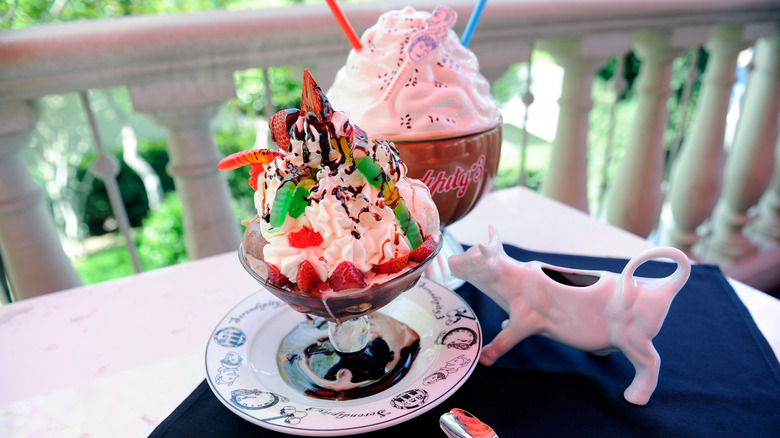How Over-The-Top Ice Cream Creations Became A Victorian-Era Trend
Ice cream is a sweet treat that has been around for centuries. There are tales of Marco Polo bringing the cold dessert westward from China and Catherine de Medici sharing its indulgent pleasures with the French (per Ice Cream Alliance). However, both of these origin stories have since been debunked. Actual historical evidence points to chilled fermented milk dating as far back as the Tang dynasty in China as the earliest likely form of ice cream.
Before freezers were invented, people mixed salt with ice to freeze foods, and this method was utilized with flavored water to make sorbets in the 1660s across Europe — in Italy, France, and Spain — and later in Naples, sweetened milk was used. Fast forward a couple hundreds of years, and humanity has given birth to the Museum of Ice Cream and many ice cream shops prioritize outrageous aesthetics in hopes of serving Instagram-worthy shots that generate buzz. But over-the-top ice cream creations actually first became a trend during the Victorian era.
Enter Agnes B. Marshall, a self-made Ice Cream Queen
We have the Victorian era of England to thank for some food traditions, like white-frosted wedding cake, cucumber sandwiches, and lavish dinners — though ours may not be quite as decadent. A Victorian dinner party often involved up to 12 or 13 courses, per The Victorian Emporium. Guests had an array of cutlery, with each one designated for a specific use, such as the ice cream fork.
When it came to ice cream etiquette, hosts of the era looked to one woman: Agnes B. Marshall. As reported by Mental Floss, she was a self-made Victorian entrepreneur who built an ice cream empire all on her own. When England began importing ice during the mid-19th century, frozen treats became more accessible to people and Marshall made moves to become the ice cream expert for the masses who were beginning to make the dessert at home.
She also wrote not one but two books on iced desserts, which included recipes for chilled soufflés, sorbets, ice creams, and more, and even opened a cookery school in 1883. Known as the "Queen of Ices", Marshall can be credited for the origins of modern ice cream trends like edible cones and liquid nitrogen ice cream (via The Hustle). Other achievements to her name include patenting an ice cream maker and ice caves to keep the desserts cold before consumption and inventing wild ice cream flavors, from foie gras to fish curry.

